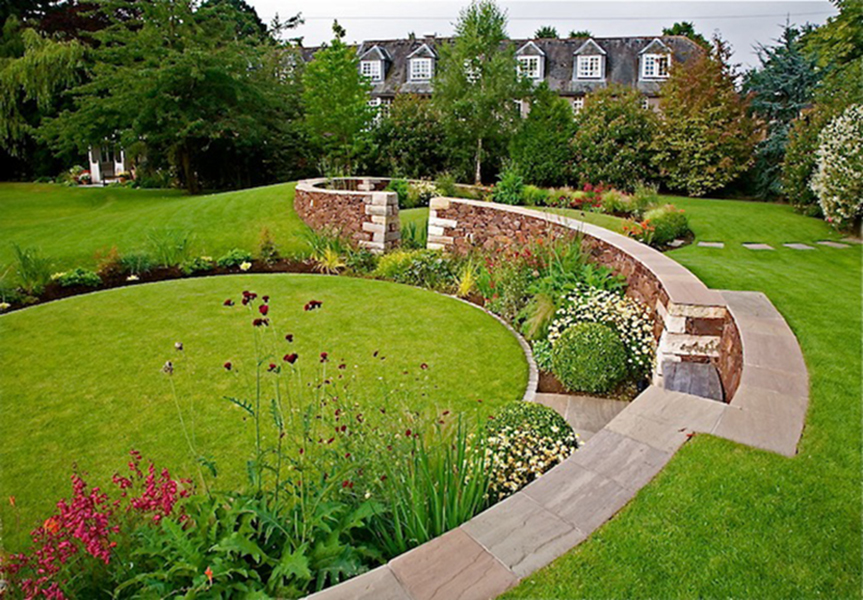
17 Dec Sunken Treasure
Four years ago, when Fiona Butler moved to a Victorian house on the south side of Edinburgh, she knew she would eventually have to tackle the back garden, which consisted of a sunken lawn on the west with a tennis-court running across the back. “It was horrible,” she says. “The tennis-court was a massive lump of cement. I was quite frightened by it all. It looked so cold, but I knew I would have to do something about it.”
The first thing she did was to replace a collection of old buildings at the back of the house with a new kitchen extension leading to a large rectangular terrace with steps to the garden. Unusually, the surface of the terrace was covered in polished concrete, while the same surface, albeit with a softer finish, was used in the kitchen. “That was absolutely key,” explains Fiona. “I wanted the same surface in the kitchen as on the terrace, so I could unify the two spaces, open up the doors and live outside. In the summer I live on the terrace.”
Directly in front of the terrace is a sunken lawn where her children – Rory, 5, and 18-month-old Cormac – play. “In the end, I decided to keep the lawn,” says Fiona. “I toyed with the idea of filling it, but I found I enjoyed sitting on the edge and watching the children play. Several of my friends urged me to keep it.” The lawn has since been given a focus by moving a summerhouse to a different position, across the lawn from the kitchen. It is painted in the same pale grey as the kitchen cabinets.
A wide flight of steps leads from the terrace down to a contrasting flagstone path, which runs the length of the house. The terrace is flanked on two sides by a border backed with bamboo, which will eventually be allowed to grow two or three feet above the level of the stone to provide extra screening and further soften the potentially sharp edges of the concrete. The bed is edged with lavender and contains a mixture of perennials and grasses to ensure there is plenty of interest all year round. Three eucalyptus trees have been set in a round gravel bed on a corner of the terrace. They draw the eye towards an intriguing dry-stone serpentine wall, which rises and falls its way across the garden – in place of the tennis-court – while winding its way around two grass circles. These circles are outlined in cobbles and framed by herbaceous borders about a metre wide.
Fiona, a former teacher whose previous experience of gardening was limited to weeding a small patio area, explains that the wall and its surrounding garden were designed by Carolyn Grohmann of Secret Gardens and built by Nick Benge of Water Gems. “The ground was so flat, and we wanted to bring some height into the garden after we got rid of the tennis-court, but we didn’t know how to achieve it,” says Fiona. It was Carolyn’s idea to build a serpentine wall, which would retain its interest even after the children had stopped using it, she says.
Built of trachyte, a stone that came from an East Lothian quarry, the wall incorporates two oak seats set in alcoves. There is a small area of paved stone in front of them and a bog garden. Nick Benge explains how it works: “This damp garden is kept moist by means of a water feature incorporated into the centre of the design, at the point where a gap in the walls allows a path to run through. The pump sits below one of the stepping-stones that cross the bog garden through the opening in the wall. It pumps water via two hoses to a pair of sandstone spouts on either side of the wall. From there the water spills into two small ponds, before travelling back across the bog garden to be recirculated.” This method ensures the area is kept moist all summer for a selection of plants, including purple Iris laevigata, yellow marsh marigold, evergreen Veronica beccabunga, water mint and purple loosestrife, threaded with a plump buttercup-shaped ranunculus.
“I feel that the garden has a bit of mystery to it now,” says Fiona, as she sits at the kitchen table looking out onto it. “You can’t see behind the wall, and the children love hiding behind it and running along the top. When I entertain friends, we sit on the grass and the children hop across the stepping-stones through the bog garden.”
Originally published in the Scotland on Sunday At Home magazine, 17th December 2006. Words by Antoinette Galbraith, photo by Ray Cox

